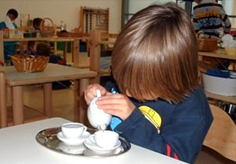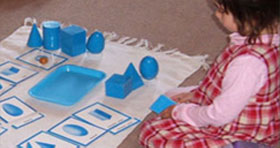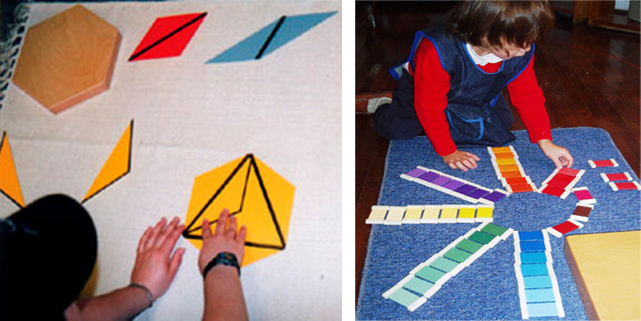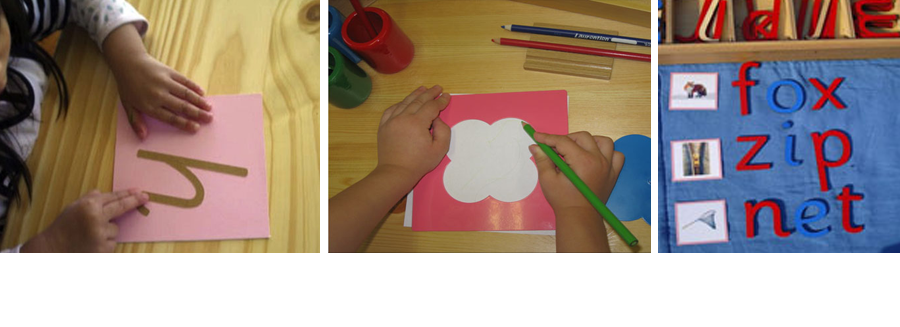Curriculum
Overview
The mantra of the unique Montessori curriculum is: "Follow the child". The curriculum takes a personalized, hands-on approach that has proven its effectiveness produces accelerated results in children.
The curriculum is composed of 7 areas:
Practical Life
 Practical Life exercises prepare the child to engage in the world around him, teaching the child care of self, care of environment, and care of others. The child performs exercises such as dressing, preparing snacks, watering plants, dishwashing, sweeping, and saying "excuse me" and "thank you". Through Practical Life exercises, the child develops motor skills and hand-eye coordination. By completing a task from start to finish, he develops good work habits, a sense of responsibility, and self-confidence. Practical Life is the foundation of Montessori education, preparing the child with essential skills to perform advanced work in Language, Math, Science and Social Studies.
Practical Life exercises prepare the child to engage in the world around him, teaching the child care of self, care of environment, and care of others. The child performs exercises such as dressing, preparing snacks, watering plants, dishwashing, sweeping, and saying "excuse me" and "thank you". Through Practical Life exercises, the child develops motor skills and hand-eye coordination. By completing a task from start to finish, he develops good work habits, a sense of responsibility, and self-confidence. Practical Life is the foundation of Montessori education, preparing the child with essential skills to perform advanced work in Language, Math, Science and Social Studies.
This area is exciting for a child because the exercises allow him to imitate ordinary adult tasks using familiar household objects. For example, children work on dressing frames with buttons, snaps, and zippers; they pour and transfer water with cups, spoons and pitchers; they sweep and polish with brooms, glasses, and cloths. All these activities help the child to become independent.

This area is exciting for a child because the exercises allow him to imitate ordinary adult tasks using familiar household objects. For example, children work on dressing frames with buttons, snaps, and zippers; they pour and transfer water with cups, spoons and pitchers; they sweep and polish with brooms, glasses, and cloths. All these activities help the child to become independent.
Sensorial

The child is learning basic geometric forms and names.
In Sensorial exercises, the child works with specially designed teaching materials that isolate one sensory experience at a time. He learns to recognize variations in color, weight, shape, texture, size, sound, and smell. For example, light blue to dark blue, small to large, hot to cold, loud to soft. Well-developed senses facilitate work in all other disciplines, such as Language, Science, Music, and Math. Being able to distinguish among shapes prepares the child for reading & writing, since shape is the defining characteristic of letters. Sensorial exercises also equip the child with the ability to comprehend abstract mathematical concepts such as Geometry and Algebra

The child is exploring different shapes of triangles as parts of a hexagon.
The child is ordering shades of different colors.
Language
Children at three to six years old have a unique fascination for words, both printed and spoken. The Montessori method takes advantage of this window of opportunity, enabling him to read and write before the age at which it is traditionally taught. The child performs a series of purposefully structured activities so that he naturally progresses from writing to reading:
 He learns to build words with Movable Alphabet and exercises word recognition by matching words to pictures.
He learns to build words with Movable Alphabet and exercises word recognition by matching words to pictures.
In the Montessori classroom, the child develops strong phonics skills so that he has the ability to attack almost any new word. Montessori classroom has many attractive books using a large number of phonetic words. As reading is the key to future learning, the teacher encourages him to explore books for answers to his questions whether they are about frogs, rockets, stars, or fire engines.
Mathematics
Dr. Montessori observed that children interested in counting enjoy touching or moving the items as they count them. Using specially designed teaching materials, a child not only sees the abstract symbol "1", "100", or "½" but can also hold the concrete quantities in his hand as beads, rods, cubes, etc. He can literally demonstrate to himself the basic operations of arithmetic by separating, counting, and comparing the materials.

The child learns the concrete meaning of 0 to 10 by working with Spindle Box, Red & Blue Rods, and Numerals & Counters.

The child learns the teen numbers and tens numbers
with Sequin Boards.
The child learns relative quantities with the Golden Beads. He uses them to add, subtract, multiply, and divide, changing units to Ten, Tens to Hundreds, Hundreds to Thousands.

The child never simply memorizes addition or multiplication tables, but rather learns by actually performing the operations with a variety of colorful and beautiful materials.
He gains a thorough understanding of arithmetic so that he can readily absorb abstract mathematical concepts.
History & Geography
Montessori aims to develop the child's geographical memory by hands on experience. And Montessori teaches children's sense of time (spring, summer, fall, winter; yesterday, today, tomorrow; days, weeks, months). In the classroom, the seasons and holidays are a weeklong celebration involving a variety of activities.

Children learn the seven continents and the map of the United States using the Puzzle Maps.
Children differentiate between Land & Water Forms by pouring water around clay land formations (island and lake, peninsula and gulf, etc.) in a pan.
Science
In the Montessori classroom, children learn the basic categories of science. Youngsters become more observant of the things that grow and live in their environment.

Children learn different leaf shapes by tracing the insets of botany cabinet.
Children learn to differentiate between plant and animal, or the five kinds of vertebrates (mammal, birds, fish, amphibians, and reptiles) using concrete figures, pictures and puzzle cabinet.
Music, Movement, & Art
Music and movement are a part of daily routine, whether it's through singing & clapping, circle time, pantomimes, musical instruments, or celebrating holidays. In this area the child learns to follow directions while developing motor coordination and cooperation with others. And the child gains a sense of rhythm, auditory discrimination and also applies language skills through singing.
In art curriculum, the children have many different art activities available to them such as painting, drawing, cutting and sculpting. They also explore, discover and manipulate a variety of media to develop creativity and joy. The art activities include projects for holidays or seasons and extensions of lessons learned in other areas of the curriculum.
 Practical Life exercises prepare the child to engage in the world around him, teaching the child care of self, care of environment, and care of others. The child performs exercises such as dressing, preparing snacks, watering plants, dishwashing, sweeping, and saying "excuse me" and "thank you". Through Practical Life exercises, the child develops motor skills and hand-eye coordination. By completing a task from start to finish, he develops good work habits, a sense of responsibility, and self-confidence. Practical Life is the foundation of Montessori education, preparing the child with essential skills to perform advanced work in Language, Math, Science and Social Studies.
Practical Life exercises prepare the child to engage in the world around him, teaching the child care of self, care of environment, and care of others. The child performs exercises such as dressing, preparing snacks, watering plants, dishwashing, sweeping, and saying "excuse me" and "thank you". Through Practical Life exercises, the child develops motor skills and hand-eye coordination. By completing a task from start to finish, he develops good work habits, a sense of responsibility, and self-confidence. Practical Life is the foundation of Montessori education, preparing the child with essential skills to perform advanced work in Language, Math, Science and Social Studies.








